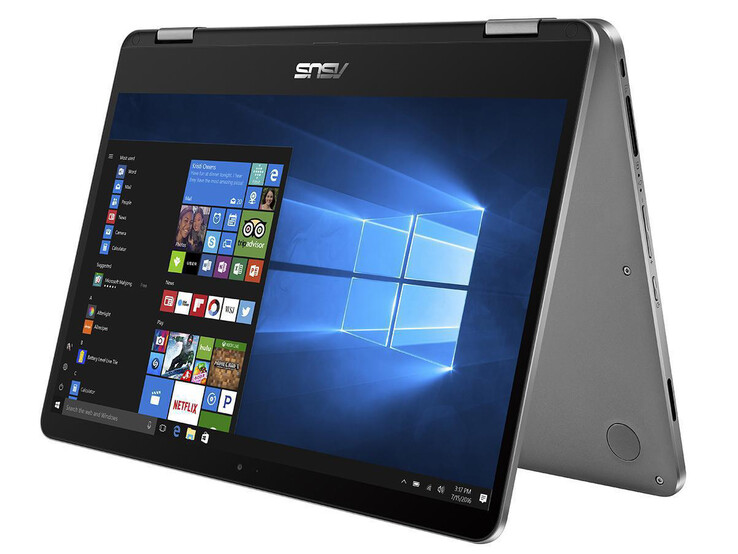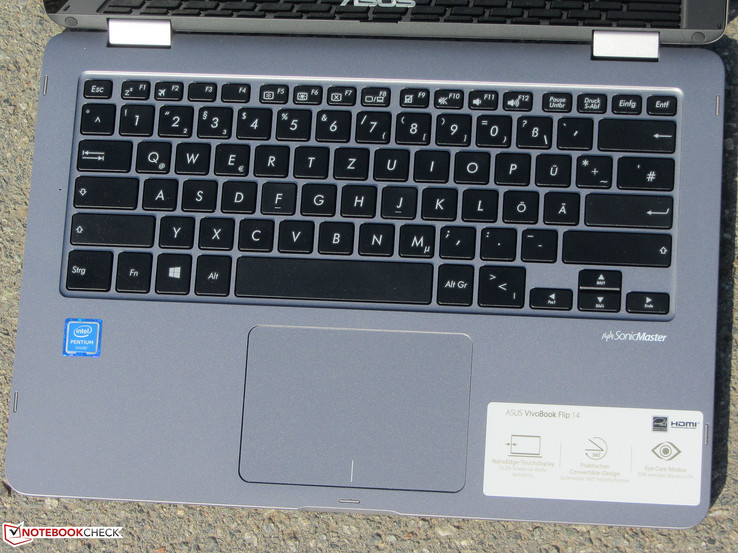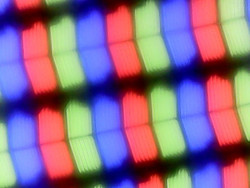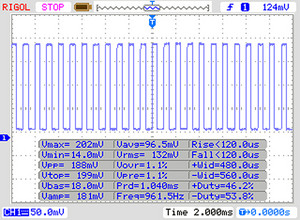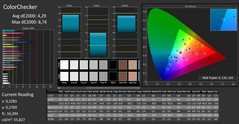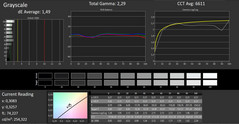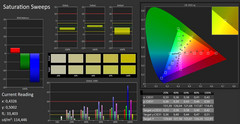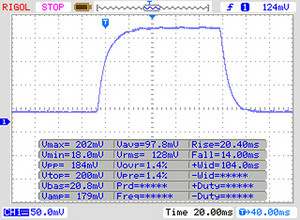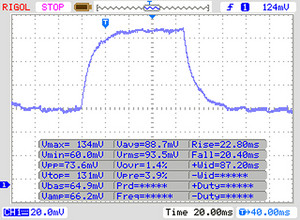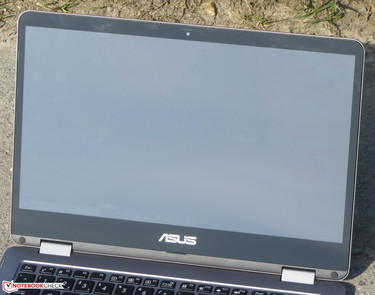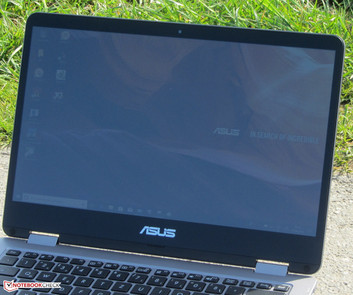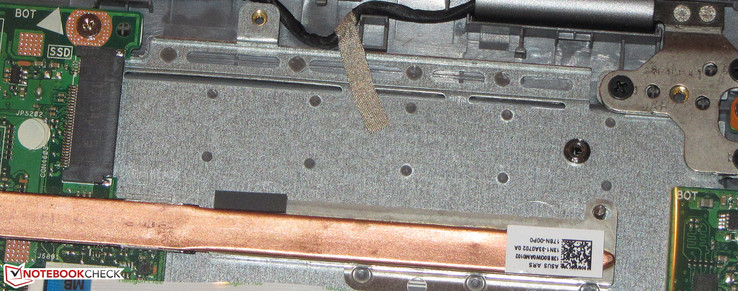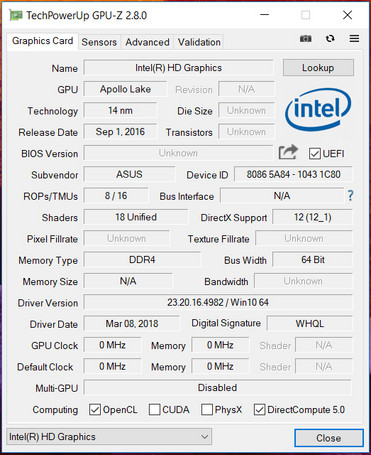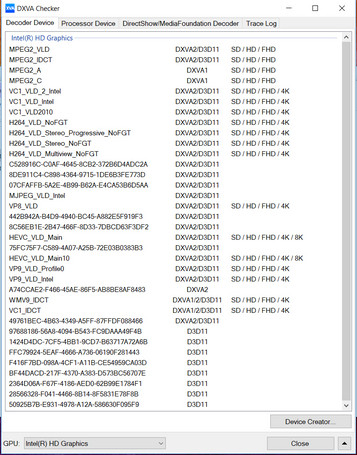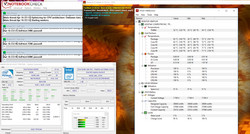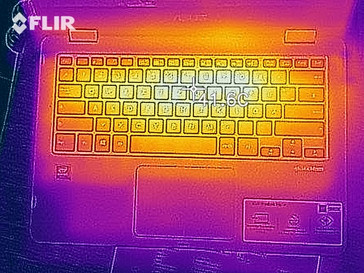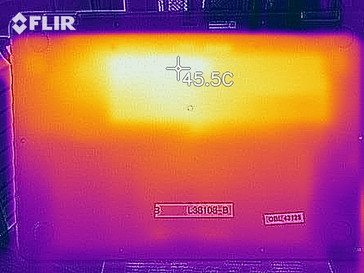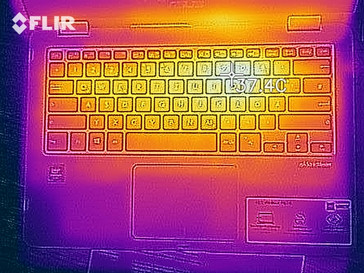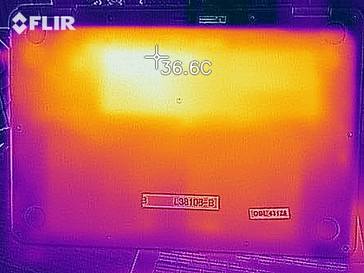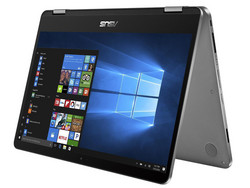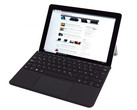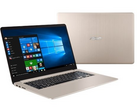Asus VivoBook Flip 14 TP401NA (N4200, FHD) Convertible Review

The Asus VivoBook Flip 14 TP 401NA is a slim, compact 14-inch convertible. It is powered by a quad-core processor of the Apollo Lake generation. The touchscreen can be operated with your fingers or with an active stylus. Some of our test unit's competitors are other convertibles such as the Acer Spin 3 SP314-51, the Lenovo Yoga 510-14AST and the Trekstor Primebook C13.
Case & Connectivity - The Asus Convertible has no Type-A USB port
Asus has equipped the VivoBook Flip with a slim, compact case. While the display cover is made of metal, the base unit is plastic. The light case is the color of anthracite and is free from any workmanship deficiencies, although it is not quite as stable as we would have hoped. The base unit can be warped without too much force and lacks rigidity. The battery cannot be removed and the device does not offer a maintenance hatch.
In order to reach the insides, the bottom of the base unit has to be taken off by removing the screws. Careful: There are additional screws hidden beneath the two rubber feet. As the bottom cover does not sit particularly tight, it can be easily removed.
Asus has given its convertible only two USB ports. The company has chosen to use one Type-C port (USB 3.1 Gen 1) and a Micro-USB port (USB 2.0). This means that you will probably always have to carry a suitable adapter with you, in order to connect things such as USB flash drives. The HDMI output also requires an adapter: Asus has chosen a MicroHDMI port.
While Asus has decided to use the compact versions of usual ports, the manufacturer has included a full-fledged SD card reader instead of a microSD model. This is not the fastest of its kind. When copying large sets of data, we reached a transfer rate of 36.3 MB/s. 250 JPG files (each about 5 MB large) are transferred at a speed of 24.5 MB/s. We tested the memory card reader with our reference card (Toshiba Exceria Pro SDXC 64 GB UHS-II).
The Wi-Fi module has a Qualcomm chip (QCA9377) and supports the Wi-Fi standards 802.11a/b/g/n as well as the fast ac standard. The transfer rates, which we tested under ideal conditions (no other Wi-Fi devices in the vicinity, close distance between notebook and server PC), are average, as the chip only supports the 1x1 MIMO technology.
Port Selection
| SD Card Reader | |
| average JPG Copy Test (av. of 3 runs) | |
| Average of class Convertible (28.1 - 209, n=23, last 2 years) | |
| Lenovo Yoga 510-14AST (Toshiba Exceria Pro SDXC 64 GB UHS-II) | |
| Asus VivoBook Flip 14 TP401NA (Toshiba Exceria Pro M501 microSDXC 64GB) | |
| Trekstor Primebook C13 (Toshiba Exceria Pro M501 microSDXC 64GB) | |
| Acer Spin 3 SP314-51-548L (Toshiba Exceria Pro SDXC 64 GB UHS-II) | |
| maximum AS SSD Seq Read Test (1GB) | |
| Average of class Convertible (28.9 - 253, n=22, last 2 years) | |
| Lenovo Yoga 510-14AST (Toshiba Exceria Pro SDXC 64 GB UHS-II) | |
| Asus VivoBook Flip 14 TP401NA (Toshiba Exceria Pro M501 microSDXC 64GB) | |
| Trekstor Primebook C13 (Toshiba Exceria Pro M501 microSDXC 64GB) | |
| Acer Spin 3 SP314-51-548L (Toshiba Exceria Pro SDXC 64 GB UHS-II) | |
| Networking | |
| iperf3 transmit AX12 | |
| Trekstor Primebook C13 | |
| Lenovo Yoga 510-14AST | |
| Acer Spin 3 SP314-51-548L | |
| Asus VivoBook Flip 14 TP401NA | |
| iperf3 receive AX12 | |
| Acer Spin 3 SP314-51-548L | |
| Asus VivoBook Flip 14 TP401NA | |
| Trekstor Primebook C13 | |
| Lenovo Yoga 510-14AST | |
Input Devices - The TP401NA can also be operated with an active stylus
Asus has equipped the convertible with a chiclet keyboard without backlighting. The flat keys with a slightly rough surface have short travel and a noticeable pressure point. The key resistance could have been made a little more crisp. Good: The keyboard does not give way while typing. Overall, Asus has provided the Flip 14 with a decent keyboard that is also suitable for regular typing.
The multi-touch ClickPad takes up an area of 10.5 x 7.3 cm (~4.13 x 2.87 in). This is a nice, large area that gives you enough space to use gesture control. The smooth surface of the touchpad makes gliding your fingers over it easy. It has short travel and a clear pressure point.
The touchscreen of the VivoBook Flip supports 10 touch points. It responds quickly to inputs and we encountered no issues when using the touchscreen, both with our fingers and with an active stylus. According to the Asus website, you can use either the Asus Pen, which is available separately, or any other active stylus.
Display - Asus has equipped the Flip 14 with a high-contrast touchscreen with stable viewing angles
The 14-inch touchscreen display of the VivoBook Flip has a native resolution of 1920x1080 pixels. The screen offers a good contrast ratio (1205:1), but its brightness could be better (239.1 cd/m²). Considering the price of the convertible, this is still quite acceptable.
Unfortunately, the display has PWM flickering at a frequency of 960 Hz up to a brightness level of 90%. Due to this high frequency, even sensitive users should be free from headaches and/or eye problems.
| |||||||||||||||||||||||||
Brightness Distribution: 76 %
Center on Battery: 253 cd/m²
Contrast: 1205:1 (Black: 0.21 cd/m²)
ΔE ColorChecker Calman: 4.29 | ∀{0.5-29.43 Ø4.77}
calibrated: 5.93
ΔE Greyscale Calman: 1.49 | ∀{0.09-98 Ø5}
59% sRGB (Argyll 1.6.3 3D)
38% AdobeRGB 1998 (Argyll 1.6.3 3D)
41.54% AdobeRGB 1998 (Argyll 3D)
59.6% sRGB (Argyll 3D)
40.21% Display P3 (Argyll 3D)
Gamma: 2.29
CCT: 6611 K
| Asus VivoBook Flip 14 TP401NA IPS, 1920x1080, 14" | Lenovo Yoga 510-14AST TN LED, 1366x768, 14" | Trekstor Primebook C13 IPS, 1920x1080, 13.3" | Acer Spin 3 SP314-51-548L IPS, 1920x1080, 14" | |
|---|---|---|---|---|
| Display | -15% | 60% | -1% | |
| Display P3 Coverage (%) | 40.21 | 34.15 -15% | 65.4 63% | 39.68 -1% |
| sRGB Coverage (%) | 59.6 | 51.4 -14% | 93.3 57% | 58.9 -1% |
| AdobeRGB 1998 Coverage (%) | 41.54 | 35.28 -15% | 66.9 61% | 41 -1% |
| Response Times | -26% | 10% | -3% | |
| Response Time Grey 50% / Grey 80% * (ms) | 42 ? | 70 ? -67% | 39 ? 7% | 43 ? -2% |
| Response Time Black / White * (ms) | 34 ? | 29 ? 15% | 30 ? 12% | 35 ? -3% |
| PWM Frequency (Hz) | 960 ? | 990 ? | 1000 | |
| Screen | -148% | -44% | 3% | |
| Brightness middle (cd/m²) | 253 | 242 -4% | 201 -21% | 220 -13% |
| Brightness (cd/m²) | 239 | 224 -6% | 207 -13% | 221 -8% |
| Brightness Distribution (%) | 76 | 88 16% | 88 16% | 78 3% |
| Black Level * (cd/m²) | 0.21 | 0.62 -195% | 0.22 -5% | 0.18 14% |
| Contrast (:1) | 1205 | 390 -68% | 914 -24% | 1222 1% |
| Colorchecker dE 2000 * | 4.29 | 13.03 -204% | 6.6 -54% | 3.98 7% |
| Colorchecker dE 2000 max. * | 8.74 | 18.79 -115% | 12.39 -42% | 7.69 12% |
| Colorchecker dE 2000 calibrated * | 5.93 | 4 33% | ||
| Greyscale dE 2000 * | 1.49 | 14.6 -880% | 7.73 -419% | 1.68 -13% |
| Gamma | 2.29 96% | 2.22 99% | 2.46 89% | 2.37 93% |
| CCT | 6611 98% | 18869 34% | 7864 83% | 6382 102% |
| Color Space (Percent of AdobeRGB 1998) (%) | 38 | 33 -13% | 61 61% | 38 0% |
| Color Space (Percent of sRGB) (%) | 59 | 52 -12% | 93 58% | 58 -2% |
| Total Average (Program / Settings) | -63% /
-105% | 9% /
-16% | -0% /
2% |
* ... smaller is better
Screen Flickering / PWM (Pulse-Width Modulation)
| Screen flickering / PWM detected | 960 Hz | ≤ 90 % brightness setting | |
The display backlight flickers at 960 Hz (worst case, e.g., utilizing PWM) Flickering detected at a brightness setting of 90 % and below. There should be no flickering or PWM above this brightness setting. The frequency of 960 Hz is quite high, so most users sensitive to PWM should not notice any flickering. In comparison: 53 % of all tested devices do not use PWM to dim the display. If PWM was detected, an average of 8084 (minimum: 5 - maximum: 343500) Hz was measured. | |||
Display Response Times
| ↔ Response Time Black to White | ||
|---|---|---|
| 34 ms ... rise ↗ and fall ↘ combined | ↗ 20 ms rise | |
| ↘ 14 ms fall | ||
| The screen shows slow response rates in our tests and will be unsatisfactory for gamers. In comparison, all tested devices range from 0.1 (minimum) to 240 (maximum) ms. » 90 % of all devices are better. This means that the measured response time is worse than the average of all tested devices (20.2 ms). | ||
| ↔ Response Time 50% Grey to 80% Grey | ||
| 42 ms ... rise ↗ and fall ↘ combined | ↗ 22 ms rise | |
| ↘ 20 ms fall | ||
| The screen shows slow response rates in our tests and will be unsatisfactory for gamers. In comparison, all tested devices range from 0.165 (minimum) to 636 (maximum) ms. » 66 % of all devices are better. This means that the measured response time is worse than the average of all tested devices (31.6 ms). | ||
Asus has equipped the convertible with an IPS panel with stable viewing angles. This means that the screen can be read easily from every position. The device can only be used outdoors if the sun is not too bright. The reflective display surface makes working outside even more difficult.
Performance- The Asus VivoBook is equipped with a quad-core processor
With its VivoBook Flip 14 TP401NA, Asus has created a light, slim 14-inch convertible. It offers sufficient computing power for office and internet applications. Our test unit will probably be available for between $400 and $500. This is an estimation, as we were not able to find the device available in our configuration. Other configurations are available from $350.
Processor
The VivoBook Flip is powered by a Pentium Silver N4200 (Apollo Lake) quad-core processor from Intel. Thanks to its low TDP of 6 watts, the chip can be cooled passively. The processor works at a base clock rate of 1.1 GHz and can increase to up to 2.5 GHz via the turbo.
The processor ran at 2.4 GHz for the first few seconds of the Cinebench multi-thread tests and then dropped to a clock rate of 1.9 to 2 GHz. The clock rate remained at 2.4 GHz for most of the single-thread tests, with the core occasionally speeding up to 2.5 GHz or dropping to 2 GHz.
We tested whether the turbo can run for a long period by running the multi-thread test from Cinebench R15 in a loop for 30 minutes. The results dropped minimally in the first four rounds and then remained constant. The turbo was used, but could not work at its maximum speed.
| Geekbench 3 | |
| 32 Bit Multi-Core Score | |
| Acer Spin 3 SP314-51-548L | |
| Asus VivoBook Flip 14 TP401NA | |
| Average Intel Pentium N4200 (4425 - 4736, n=6) | |
| Lenovo Yoga 510-14AST | |
| 32 Bit Single-Core Score | |
| Acer Spin 3 SP314-51-548L | |
| Lenovo Yoga 510-14AST | |
| Asus VivoBook Flip 14 TP401NA | |
| Average Intel Pentium N4200 (1362 - 1430, n=6) | |
| Geekbench 4.4 | |
| 64 Bit Multi-Core Score | |
| Acer Spin 3 SP314-51-548L | |
| Average Intel Pentium N4200 (4468 - 4729, n=4) | |
| Asus VivoBook Flip 14 TP401NA | |
| 64 Bit Single-Core Score | |
| Acer Spin 3 SP314-51-548L | |
| Average Intel Pentium N4200 (1544 - 1616, n=4) | |
| Asus VivoBook Flip 14 TP401NA | |
| JetStream 1.1 - Total Score | |
| Acer Spin 3 SP314-51-548L (Edge 41) | |
| Lenovo Yoga 510-14AST (Edge 38) | |
| Average Intel Pentium N4200 (56.4 - 91.5, n=14) | |
| Asus VivoBook Flip 14 TP401NA (Edge 41) | |
| Trekstor Primebook C13 | |
System Performance
The system runs smoothly and benefits from the comparatively fast eMMC storage that Asus has given the Flip 14. Therefore, the system gives a better impression than that of comparable devices. The device was not made for high-end performance, but the SoC is good enough for office and internet applications. The results in the PCMark benchmarks correspond with the performance the SoC can offer. It is not possible to increase system performance.
| PCMark 8 Home Score Accelerated v2 | 1966 points | |
| PCMark 8 Creative Score Accelerated v2 | 2394 points | |
| PCMark 8 Work Score Accelerated v2 | 2646 points | |
| PCMark 10 Score | 1454 points | |
Help | ||
Storage Devices
The system drive is an eMMC module that has a capacity of 128 GB. 91.5 GB is available for personal use while the rest is taken up by the Windows operating system and Recovery partition. The transfer rates are comparatively good. Asus seems to have chosen an up-to-date eMMC storage device.
Luckily, Asus has not made the mistake that has been made in many comparable devices: These are often equipped with 32-GB modules, which are simply not large enough for a Windows 10 system. Manufacturers are trying to cut the wrong corners in order to minimize the device's price. We would recommend a minimum capacity of 64 GB.
If the available storage capacity and/or the transfer rates of the eMMC storage do not fulfil your needs, you can additionally install a M.2 2280 SATA III SSD - the VivoBook has the necessary slot. You could also install Windows 10 on it, however the eMMC module cannot be deactivated, so that would mean having two Windows operating systems installed. Expanding storage via an SD card is not ideal as the card stands out of the slot by 17 mm (~0.67 in).
| Asus VivoBook Flip 14 TP401NA 128 GB eMMC Flash | Lenovo Yoga 510-14AST | Trekstor Primebook C13 SanDisk DF4064 | Acer Spin 3 SP314-51-548L Micron 1100 MTFDDAV256TBN | Average 128 GB eMMC Flash | Average of class Convertible | |
|---|---|---|---|---|---|---|
| CrystalDiskMark 3.0 | 186% | -31% | 316% | -35% | 2528% | |
| Read Seq (MB/s) | 263.1 | 434.6 65% | 265.4 1% | 484.3 84% | 184.8 ? -30% | 3753 ? 1326% |
| Write Seq (MB/s) | 191.5 | 207.7 8% | 113.8 -41% | 439.8 130% | 86.4 ? -55% | 4028 ? 2003% |
| Read 512 (MB/s) | 218.4 | 356.3 63% | 207.2 -5% | 316.4 45% | 157.8 ? -28% | 950 ? 335% |
| Write 512 (MB/s) | 178.5 | 195.6 10% | 85.9 -52% | 345.4 94% | 73.5 ? -59% | 1522 ? 753% |
| Read 4k (MB/s) | 24.11 | 26.71 11% | 5.212 -78% | 27.17 13% | 14.5 ? -40% | 1382 ? 5632% |
| Write 4k (MB/s) | 19.36 | 56.8 193% | 9.903 -49% | 86.7 348% | 13.1 ? -32% | 1630 ? 8319% |
| Read 4k QD32 (MB/s) | 28.6 | 176.3 516% | 32.26 13% | 246.7 763% | 26.6 ? -7% | 220 ? 669% |
| Write 4k QD32 (MB/s) | 22.65 | 163.3 621% | 13.83 -39% | 260.6 1051% | 15.3 ? -32% | 292 ? 1189% |
Graphics
Intel's HD Graphics 505 is responsible for the graphics department. The GPU supports DirectX 12 and works at speeds of up to 750 MHz. The results in the 3DMark benchmark are normal for this GPU. The integrated decoder can unburden the processor when playing videos in the usual formats such as H.265, VP9 and HEVC/H.265.
| 3DMark 11 Performance | 667 points | |
| 3DMark Cloud Gate Standard Score | 2730 points | |
| 3DMark Fire Strike Score | 383 points | |
Help | ||
Gaming Performance
The hardware of the TP401NA can display only a few games from our database smoothly - and only if the resolution and quality settings are set to low. These are games that have very low demands on the hardware. You can find games that can be displayed more easily in the Casual Games section of the Microsoft Store.
| low | med. | high | ultra | |
|---|---|---|---|---|
| StarCraft 2 (2010) | 69.7 | 15.9 | 9.7 | |
| Anno 2070 (2011) | 31.1 | 14.8 | 9.3 | |
| BioShock Infinite (2013) | 24.9 | 10.7 | 9.4 | |
| GRID 2 (2013) | 36.8 | 19.4 | 12.5 | |
| Middle-earth: Shadow of Mordor (2014) | 12.4 | 7.7 | ||
| Overwatch (2016) | 7.1 | |||
| Team Fortress 2 (2017) | 28 | 25.2 | ||
| F1 2017 (2017) | 13 | |||
| ELEX (2017) | 4.6 | |||
| Assassin´s Creed Origins (2017) | 2 | |||
| Need for Speed Payback (2017) | 2 | |||
| Star Wars Battlefront 2 (2017) | 2.8 | |||
| X-Plane 11.11 (2018) | 5.5 | |||
| Far Cry 5 (2018) | 3 |
Emissions & Energy - The Asus laptop works silently
System Noise
The VivoBook Flip has neither a cooling fan nor a mechanical hard drive and therefore operates silently.
Temperature
The Flip 14 TP401NA offers the same performance when running on power supply and on battery during our stress test. The processor works at 1.1 to 1.2 GHz. The graphics core starts the test with speeds between 150 and 250 MHz, but then drops to 100 to 150 MHz later on.
The notebook does not heat up particularly. We only measured 40 °C (~104 °F) in one area during our stress test.
(±) The maximum temperature on the upper side is 40 °C / 104 F, compared to the average of 35.4 °C / 96 F, ranging from 19.6 to 60 °C for the class Convertible.
(+) The bottom heats up to a maximum of 39.5 °C / 103 F, compared to the average of 36.8 °C / 98 F
(+) In idle usage, the average temperature for the upper side is 29.3 °C / 85 F, compared to the device average of 30.3 °C / 87 F.
(+) The palmrests and touchpad are cooler than skin temperature with a maximum of 28.1 °C / 82.6 F and are therefore cool to the touch.
(±) The average temperature of the palmrest area of similar devices was 27.9 °C / 82.2 F (-0.2 °C / -0.4 F).
Speakers
Asus has placed a speaker on either side of the case. They produce a full-bodied, pleasant sound that can be listened to for a while, despite it being slightly muffled. Alternatively, you can also connect headphones or external speakers.
Asus VivoBook Flip 14 TP401NA audio analysis
(-) | not very loud speakers (63.5 dB)
Bass 100 - 315 Hz
(±) | reduced bass - on average 9% lower than median
(-) | bass is not linear (17.4% delta to prev. frequency)
Mids 400 - 2000 Hz
(+) | balanced mids - only 2.8% away from median
(+) | mids are linear (6.9% delta to prev. frequency)
Highs 2 - 16 kHz
(±) | higher highs - on average 5.1% higher than median
(+) | highs are linear (6.2% delta to prev. frequency)
Overall 100 - 16.000 Hz
(±) | linearity of overall sound is average (18.5% difference to median)
Compared to same class
» 40% of all tested devices in this class were better, 8% similar, 52% worse
» The best had a delta of 6%, average was 20%, worst was 57%
Compared to all devices tested
» 41% of all tested devices were better, 8% similar, 52% worse
» The best had a delta of 4%, average was 24%, worst was 134%
Apple MacBook 12 (Early 2016) 1.1 GHz audio analysis
(+) | speakers can play relatively loud (83.6 dB)
Bass 100 - 315 Hz
(±) | reduced bass - on average 11.3% lower than median
(±) | linearity of bass is average (14.2% delta to prev. frequency)
Mids 400 - 2000 Hz
(+) | balanced mids - only 2.4% away from median
(+) | mids are linear (5.5% delta to prev. frequency)
Highs 2 - 16 kHz
(+) | balanced highs - only 2% away from median
(+) | highs are linear (4.5% delta to prev. frequency)
Overall 100 - 16.000 Hz
(+) | overall sound is linear (10.2% difference to median)
Compared to same class
» 7% of all tested devices in this class were better, 2% similar, 91% worse
» The best had a delta of 5%, average was 18%, worst was 53%
Compared to all devices tested
» 4% of all tested devices were better, 1% similar, 94% worse
» The best had a delta of 4%, average was 24%, worst was 134%
Power Consumption
We did not notice anything unusual in terms of power consumption. While idling, we measured a maximum consumption of 7.44 watts. This increased to up to 15.6 watts during the stress test. The power supply has a rated output of 45 watts.
| Off / Standby | |
| Idle | |
| Load |
|
Key:
min: | |
Battery Runtimes
We used our practical Wi-Fi test to simulate the load of surfing the web. The profile "Balanced" was active and the display brightness was set to about 150 cd/m². The VivoBook Flip reached a runtime of 6:31 h.
Pros
Cons
Verdict
The slim, compact 14-inch convertible is powered by a Pentium Silver N4200 quad-core processor that offers sufficient processing power for internet and office applications. Thanks to its passive cooling, the TP401NA operates silently.
The storage capacity of the Asus is sufficiently large: The system drive is a 128-GB eMMC module. The storage capacity can also be expanded by installing an M.2 2280 SSD in the provided slot.
The Full HD IPS touchscreen impresses with its stable viewing angles and good contrast ratio. The brightness, however, is rather low. The touchscreen can be operated with your fingers or with an active stylus.
Asus has created the VivoBook Flip 14 TP401NA, a convertible that gives a good impression despite having some weaknesses.
The keyboard seems to be very decent and is suitable for regular typing. The battery runtimes are only average. As Asus has decided to forego the usual Type-A USB port, buyers should always carry an adapter with them.
The model TP401NA EC007T appears to be the most attractive of all available configurations. This has a RAM of 4 GB and a storage device of 64 GB and is currently available for $350.
Asus VivoBook Flip 14 TP401NA
- 04/24/2018 v6 (old)
Sascha Mölck




